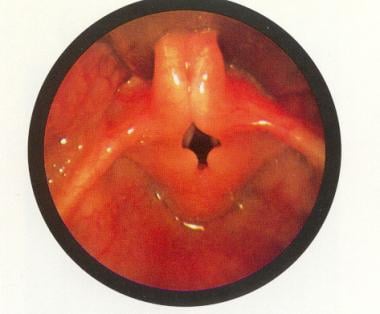Practice Essentials
Laryngomalacia is a congenital abnormality of the laryngeal cartilage (see the image below). It is a dynamic lesion resulting in collapse of the supraglottic structures during inspiration, leading to airway obstruction. It is thought to represent a delay of maturation of the supporting structures of the larynx. Laryngomalacia is the most common cause of congenital stridor and is the most common congenital lesion of the larynx.
 The epiglottis is small and curled on itself (omega-shaped). Approximation of the posterior edges of the epiglottis contributes to the inspiratory obstruction. Used with permission from Oxford University Press [Benjamin B. Atlas of Paediatric Endoscopy: Upper Respiratory Tract and Oesphagus. New York, NY: Oxford University Press; 1981.]
The epiglottis is small and curled on itself (omega-shaped). Approximation of the posterior edges of the epiglottis contributes to the inspiratory obstruction. Used with permission from Oxford University Press [Benjamin B. Atlas of Paediatric Endoscopy: Upper Respiratory Tract and Oesphagus. New York, NY: Oxford University Press; 1981.]
The pathology is unknown. In cases in which redundant or tight tissue has been removed, it is histologically indistinct from normal tissue. No genetic pattern is known.
Signs and symptoms
The typical history in patients with laryngomalacia is of inspiratory noises that begin during the first 2 months of life. Mild tachypnea may be present.
See Presentation for more detail.
Diagnosis
Laryngoscopy and bronchoscopy are the best studies used to confirm the diagnosis. However, in infants with typical inspiratory noises (worse when supine) who have a normal cry and normal growth and development, clinical diagnosis is not unreasonable.
See Workup for more detail.
Management
In more than 90% of cases, the only treatment necessary for laryngomalacia is time. The lesion gradually improves, and noises disappear by age 2 years in virtually all infants. Supraglottoplasty may be of benefit in children with severe symptoms of laryngomalacia.
See Treatment and Medication for more detail.
Pathophysiology
Laryngomalacia may affect the epiglottis, the arytenoid cartilages, or both. When the epiglottis is involved, it is often elongated, and the walls fold in on themselves. The epiglottis in cross section resembles an omega, and the lesion has been referred to as an omega-shaped epiglottis. If the arytenoid cartilages are involved, they appear enlarged. In either case, the cartilage is floppy and is noted to prolapse over the larynx during inspiration. This inspiratory obstruction causes an inspiratory noise, which may be high-pitched sounds frequently heard in other causes of stridor, coarse sounds resembling nasal congestion, and low-pitched stertorous noises. More severe compromise may be associated with a lower ratio of the aryepiglottic fold length to the glottic length.
A classification system has been proposed. In type 1 laryngomalacia, the aryepiglottic folds are tightened or foreshortened. Type 2 is marked by redundant soft tissue in any area of the supraglottic region. Type 3 is associated with other disorders, such as neuromuscular disease and gastroesophageal reflux.
Laryngomalacia is the most common cause of chronic inspiratory noise in infants, no matter which type of noise is heard. Infants with laryngomalacia have a higher incidence of gastroesophageal reflux, presumably a result of the more negative intrathoracic pressures necessary to overcome the inspiratory obstruction. Conversely, children with significant reflux may have pathologic changes similar to laryngomalacia, especially enlargement and swelling of the arytenoid cartilages. Some of the swelling of the arytenoid cartilages and of the epiglottis may be secondary to reflux.
Occasional inflammatory changes are observed in the larynx, which is referred to as reflux laryngitis. When the epiglottis is involved, gravity makes the noise more prominent when the baby is supine.
The exaggerated inspiratory effort increases blood return to the pulmonary vascular bed. This could account for the increased likelihood of pulmonary artery hypertension in infants with hypoxemia.
Epidemiology
United States statistics
Frequency is unknown. Often, the diagnosis is presumed.
Race-, sex-, and age-related demographics
Race
No known race predilection has been reported.
Sex
Although previous reports in predominately White populations have reported a male predominance (58-76% of cases), a more recent study of a more ethnically diverse population demonstrated no significant difference between males and females. [1]
Age
Although this is a congenital lesion, airway sounds typically begin at age 4-6 weeks. Until that age, inspiratory flow rates may not be high enough to generate the sounds. Symptoms typically peak at age 6-8 months and remit by age 2 years.
Late-onset laryngomalacia may be a distinct entity, which can present after age 2 years.
Prognosis
Prognosis is excellent. Most babies outgrow the condition by their second birthday, many by the first. In some cases, even though the signs and symptoms dissipate, the pathology persists. Such patients may have stridor with exercise later in life.
Laryngomalacia may be more common in children with Down syndrome, in whom it may persist beyond the second birthday.
Morbidity/mortality
Rarely, the lesion may cause enough hypoxemia or hypoventilation to interfere with normal growth and development. In severe cases, when laryngomalacia may be associated with gastroesophageal reflux, feeding problems such as choking or gagging may occur.
Complications
Complications include the following:
-
Poor oxygenation that requires supplemental oxygen
-
Alveolar hypoventilation that requires surgery or positive pressure ventilation
-
Apnea
-
Increased likelihood of gastroesophageal reflux
-
Pulmonary hypertension
-
The epiglottis is small and curled on itself (omega-shaped). Approximation of the posterior edges of the epiglottis contributes to the inspiratory obstruction. Used with permission from Oxford University Press [Benjamin B. Atlas of Paediatric Endoscopy: Upper Respiratory Tract and Oesphagus. New York, NY: Oxford University Press; 1981.]






